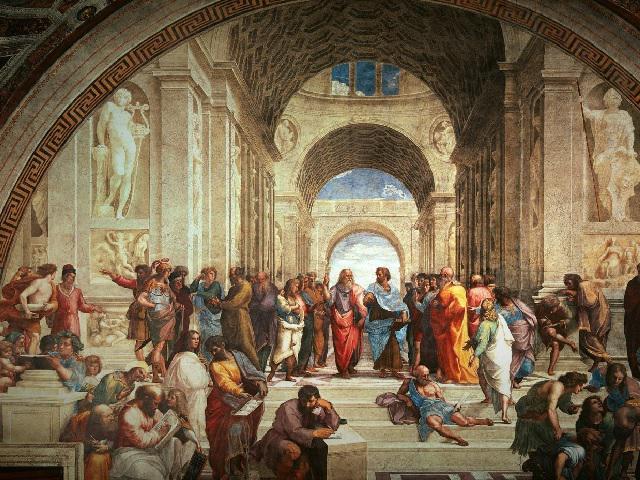The School of Athens

The School of Athens is a masterpiece of Renaissance art, created by the renowned Italian painter Raphael of Sanzio in 1512. This iconic painting is located in the Vatican City, specifically in the Apostolic Palace, where it adorns the walls of the Stanza della Segnatura. The fresco is a true testament to Raphael's talent and skill, showcasing his ability to capture the essence of philosophy and classical thought in a single composition.
As we stand before The School of Athens, we are transported back in time to a gathering of some of the most influential philosophers, scientists, and mathematicians of the classical era. The painting is set within a grandiose Renaissance architecture, with each figure meticulously placed to convey a sense of harmony and balance. In the center of the composition, we see Plato and Aristotle engaged in deep conversation, symbolizing the eternal debate between idealism and realism.
Moving our gaze across the painting, we can easily recognize other prominent figures such as Pythagoras, Diogenes, and Heraclitus, each depicted with their own distinctive attributes and gestures. The attention to detail in The School of Athens is truly remarkable, with every figure exuding a sense of intellectual curiosity and contemplation. It is said that Raphael even included a self-portrait in the painting, subtly blending himself into this illustrious gathering of minds.
To the right of the painting, we find Raphael's self-portrait, a young man with brown hair and a blue hat, gazing out at the viewer with a sense of introspection. On the left, Hypatia of Alexandria stands out in her white attire, embodying the spirit of female intellect and empowerment. The composition of The School of Athens is not only a visual feast for the eyes but also a profound exploration of the human quest for knowledge and understanding.
In conclusion, The School of Athens is more than just a painting; it is a timeless masterpiece that continues to inspire and captivate viewers from around the world. Raphael's genius shines through in every brushstroke, inviting us to ponder the mysteries of the universe and the enduring legacy of classical thought. As we marvel at this iconic work of art, we are reminded of the power of ideas and the transformative impact of philosophy on human civilization.
© ChatGPT 3.5
*It is said that Raphael's last words were “I am thirsty, give me wine, a carafe of wine.” He died at the age of 37 on the same day he was born, Good Friday.
*This prodigy artist began painting The School of Athens at the age of 27.
*Its dimensions are considerable: almost eight meters long by five meters high.
*It was made in sketch between 1509 and 1510 and painted between 1510 and 1512 as part of a commission to decorate with frescoes the rooms that today are known as Raphael's rooms, located in the Vatican.
*It is located in the Vatican in the Signature Room I, which used to be a library where there are four walls that illustrate the four areas of human knowledge: philosophy, theology, poetry and justice.
*The captured scene is inserted within an architectural framework, based on a Roman temple but with the already present imprint of Renaissance architecture, reminiscent of the new Basilica of San Pedro de Bramante.